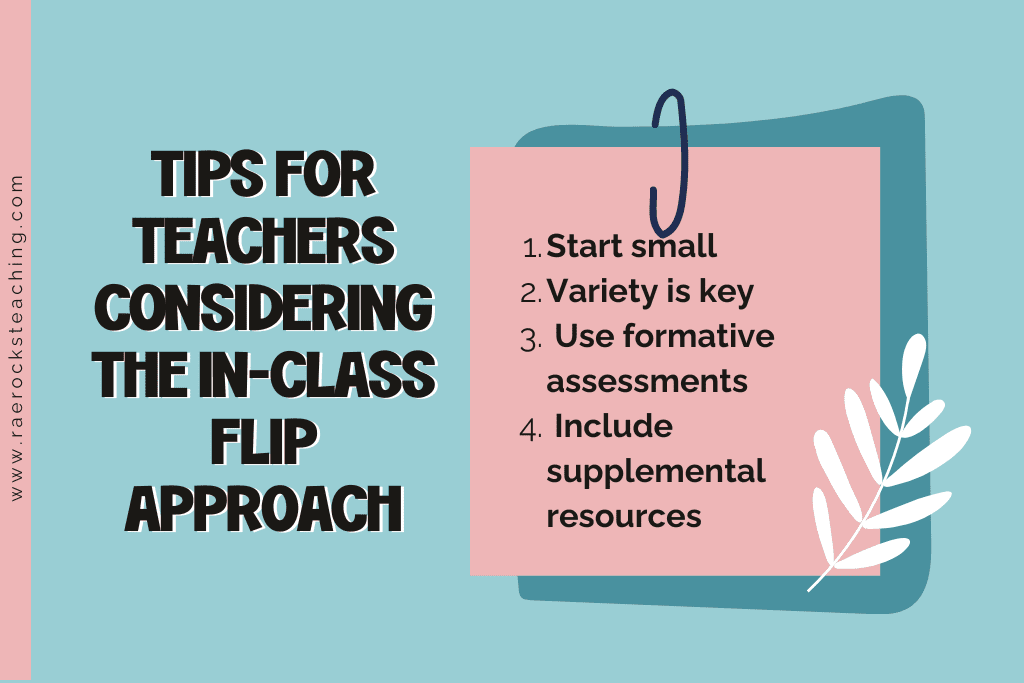Have you thought “are flipped classrooms effective?” I know I used to question this approach, but after years of trial and error, I can safely say YES, they do work when executed properly! The flipped classroom, an educational approach where students learn concepts at home and practice them in class with teacher guidance, has gained significant traction in recent years. However, a key debate surrounds the role of homework in this model. While traditional flipped classrooms often assign pre-class video lectures as “homework,” a growing trend challenges this notion – the “In-Flip” approach. This blog post dives into the effectiveness of flipped classrooms without homework, exploring the benefits and potential drawbacks of this innovative technique.
Looking for more ways to engage your lessons in class?
The Traditional Flipped Classroom: Pros and Cons
What happens in flipped classroom? The classic flipped classroom model emphasizes independent learning outside of class. Students typically watch pre-recorded lectures, read assigned materials, or complete online activities at home. This frees up valuable classroom time for interactive exercises, problem-solving activities, and group discussions, allowing teachers to tailor support to individual needs.
Here are some key advantages of the traditional flipped classroom:
- Deeper Learning: Students can control their learning pace at home, allowing for a better understanding of foundational concepts before diving into in-class activities.
- Active Learning: In-class time becomes more engaging, with students actively applying their knowledge rather than passively listening to lectures.
- Differentiation: Teachers can personalize instruction based on student comprehension during class activities.

-
Save
However, the traditional flipped classroom with homework isn’t without its critics. Some argue that assigning homework, especially video lectures, can be:
- Time-consuming: Students with busy schedules or slow internet access may struggle to complete pre-class work on time.
- Ineffective: Not all students learn optimally through video lectures, and pre-recorded material may lack interactivity.
- Disengaging: Students might passively watch lectures without actively engaging with the material, negating the intended benefits.
The Rise of the In-Class Flip: Flipped Classrooms Without Homework
The In-Class Flip approach proposes a different strategy. Instead of traditional homework, the learning happens directly in class. Teachers present key concepts in engaging ways through mini-lectures, demonstrations, or collaborative activities. This sets the stage for deeper exploration and application during the remaining class time.
Benefits of Flipped Classrooms Without Homework
The In-Class Flip offers several advantages over the traditional model:
- Equity and Accessibility: All students learn the material together during class time, eliminating the disadvantages associated with traditional homework.
- Maximized Class Time: Every minute spent in class is dedicated to active learning, maximizing engagement and fostering a collaborative classroom environment.
- Teacher Control: The teacher has full control over the delivery of new information, ensuring a clear and impactful presentation of key concepts.

-
Save

-
Save
Challenges of Flipped Classrooms Without Homework
While promising, the In-Flip approach also comes with potential hurdles:
- Teacher Preparation: Crafting engaging and efficient in-class presentations to replace pre-class learning takes significant preparation time from teachers.
- Class Size: The In-Flip model might be less effective in large class sizes, as individual attention and student participation may be less manageable.
- Prior Knowledge Gaps: Students with pre-existing knowledge gaps might struggle to keep pace if the material is introduced entirely in class.
Finding the Right Balance: Flipping for Your Needs
The effectiveness of homework-free flipped classrooms depends heavily on factors like class size, student learning styles, and the teacher’s comfort level with the approach.
Here are some tips for teachers considering the In-Flip approach:
- Start Small: Begin by flipping a single unit or topic to gauge student engagement and assess the workload implications.
- Variety is Key: Utilize various in-class activities to cater to different learning styles. Consider incorporating short quizzes, simulations, group discussions, and problem-solving exercises.
- Formative Assessment: Regularly assess student understanding throughout the in-class session to identify areas that need clarification or review.
- Supplemental Resources: Offer optional online resources or activities for students who wish to explore further outside of class.

-
Save
Ultimately, the choice between a traditional flipped classroom with homework or a homework-free In-Class Flip approach hinges on the specific context and learning goals. Both methods offer unique advantages, and teachers can experiment to find the best fit for their students and teaching style.
The flipped classroom debate continues to evolve, and the In-Class Flip model highlights the importance of maximizing in-class time for active learning. By carefully considering the benefits and drawbacks of both approaches, you can create a dynamic and engaging learning environment that caters to the diverse needs of your students.
Don’t forget to Sign up for the FREE GUIDE | Flip & Thrive: Your 5-Step Quickstart Guide to a More Engaging Classroom

-
Save
I love sharing helpful content with y’all and would love to connect on IG or Facebook. I’m on TikTok too! Follow me and send me a DM with what you need more of because I’m here to help! If you are looking for even more inspiration, find me on Pinterest!
Share via:









2 Responses